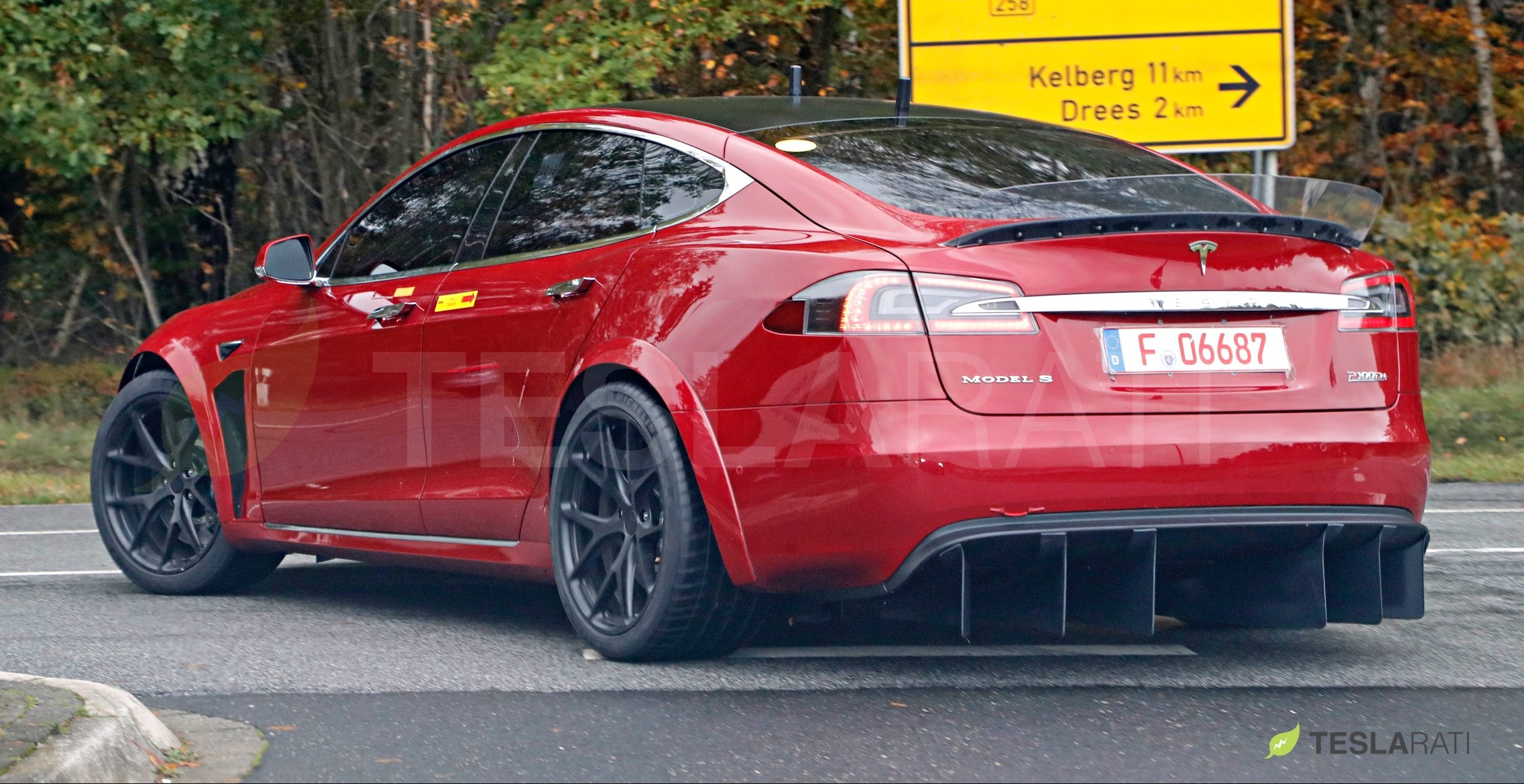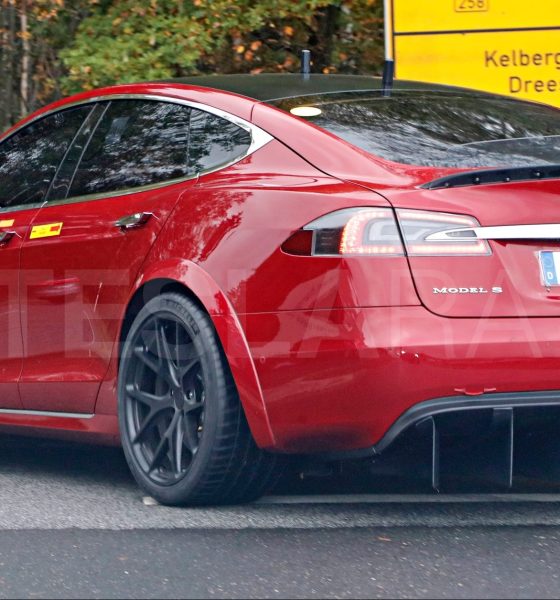

News
Tesla’s Project ‘Roadrunner’ opens the doors for the Model S Plaid’s release
Documents and filings about Tesla’s facility in Kato Road, near the Fremont Factory, suggest that the electric car maker is attempting to ramp its operations on the site, which is rumored to be an in-house battery research and manufacturing facility. The project, dubbed “Roadrunner,” is expected to start producing battery cells that are created by Tesla, for Tesla vehicles. And in a way, such a project could pave the way for the release of the company’s next flagship sedan: the Model S Plaid.
Recent filings from the company to the City of Fremont indicate that Tesla has a “small-scale” battery manufacturing operation in the city. That said, the company is now planning on ramping its operations, with workers increasing to 470 people overall, 400 of which “work in shifts, such that there are 100 employees working at manufacturing and production operations at any given time, all day, every day.”
Details of project Roadrunner have not been disclosed by Tesla, though expectations are high that it would play a huge role in the upcoming Battery Day event, which is scheduled this September. Just like the Kato Road facility, official details about Battery Day are quite slim, though speculations suggest that Tesla would be discussing the development of its next-generation cells, the million-mile battery.
The implications for the million-mile battery are numerous, from electric vehicles that could outlast their internal combustion counterparts to battery storage systems that could last literal decades. But apart from these advantages, better batteries could also help electric vehicles tap into even higher levels of performance. Fortunately, Tesla actually has a vehicle lined up with such a goal in mind. It was even sent over to the Nurburgring last year, where it set unofficial records before it was brought home to the United States.
This vehicle is the Tesla Model S Plaid. The Plaid Model S is, as per Elon Musk, equipped with three electric motors that would allow the vehicle to perform even better than the already impressive Raven Model S Performance that’s available today. What is particularly interesting is that neither Tesla nor Musk has spoken about the Model S Plaid’s battery. Speculations from the Tesla community suggest that the upcoming variant of the flagship sedan could be the perfect first vehicle to carry the company’s next breed of batteries.
In a way, it would be almost poetic. The Model S is the vehicle that represents the point when Tesla hit its stride as a legitimate automaker. It is also the car that put Tesla on the map in the car industry, with the vehicle sweeping multiple awards during its tenure. It would then be unsurprising if Tesla rolls out its next-generation batteries on the pinnacle of the Model S as well.
Such a project would be a good match too, considering that the Kato Road facility is just a pilot battery cell production line, and thus, likely able to support only a limited number of vehicles per year. What’s more, Elon Musk has also suggested that the Plaid Model S’ was poised for a 2020 release, practically making it a perfect fit for the company’s project Roadrunner ramp.

News
Tesla FSD fleet is nearing 7 billion total miles, including 2.5 billion city miles
As can be seen on Tesla’s official FSD webpage, vehicles equipped with the system have now navigated over 6.99 billion miles.

Tesla’s Full Self-Driving (Supervised) fleet is closing in on almost 7 billion total miles driven, as per data posted by the company on its official FSD webpage.
These figures hint at the massive scale of data fueling Tesla’s rapid FSD improvements, which have been quite notable as of late.
FSD mileage milestones
As can be seen on Tesla’s official FSD webpage, vehicles equipped with the system have now navigated over 6.99 billion miles. Tesla owner and avid FSD tester Whole Mars Catalog also shared a screenshot indicating that from the nearly 7 billion miles traveled by the FSD fleet, more than 2.5 billion miles were driven inside cities.
City miles are particularly valuable for complex urban scenarios like unprotected turns, pedestrian interactions, and traffic lights. This is also the difference-maker for FSD, as only complex solutions, such as Waymo’s self-driving taxis, operate similarly on inner-city streets. And even then, incidents such as the San Francisco blackouts have proven challenging for sensor-rich vehicles like Waymos.
Tesla’s data edge
Tesla has a number of advantages in the autonomous vehicle sector, one of which is the size of its fleet and the number of vehicles training FSD on real-world roads. Tesla’s nearly 7 billion FSD miles then allow the company to roll out updates that make its vehicles behave like they are being driven by experienced drivers, even if they are operating on their own.
So notable are Tesla’s improvements to FSD that NVIDIA Director of Robotics Jim Fan, after experiencing FSD v14, noted that the system is the first AI that passes what he described as a “Physical Turing Test.”
“Despite knowing exactly how robot learning works, I still find it magical watching the steering wheel turn by itself. First it feels surreal, next it becomes routine. Then, like the smartphone, taking it away actively hurts. This is how humanity gets rewired and glued to god-like technologies,” Fan wrote in a post on X.
News
Tesla starts showing how FSD will change lives in Europe
Local officials tested the system on narrow country roads and were impressed by FSD’s smooth, human-like driving, with some calling the service a game-changer for everyday life in areas that are far from urban centers.

Tesla has launched Europe’s first public shuttle service using Full Self-Driving (Supervised) in the rural Eifelkreis Bitburg-Prüm region of Germany, demonstrating how the technology can restore independence and mobility for people who struggle with limited transport options.
Local officials tested the system on narrow country roads and were impressed by FSD’s smooth, human-like driving, with some calling the service a game-changer for everyday life in areas that are far from urban centers.
Officials see real impact on rural residents
Arzfeld Mayor Johannes Kuhl and District Administrator Andreas Kruppert personally tested the Tesla shuttle service. This allowed them to see just how well FSD navigated winding lanes and rural roads confidently. Kruppert said, “Autonomous driving sounds like science fiction to many, but we simply see here that it works totally well in rural regions too.” Kuhl, for his part, also noted that FSD “feels like a very experienced driver.”
The pilot complements the area’s “Citizen Bus” program, which provides on-demand rides for elderly residents who can no longer drive themselves. Tesla Europe shared a video of a demonstration of the service, highlighting how FSD gives people their freedom back, even in places where public transport is not as prevalent.
What the Ministry for Economic Affairs and Transport says
Rhineland-Palatinate’s Minister Daniela Schmitt supported the project, praising the collaboration that made this “first of its kind in Europe” possible. As per the ministry, the rural rollout for the service shows FSD’s potential beyond major cities, and it delivers tangible benefits like grocery runs, doctor visits, and social connections for isolated residents.
“Reliable and flexible mobility is especially vital in rural areas. With the launch of a shuttle service using self-driving vehicles (FSD supervised) by Tesla in the Eifelkreis Bitburg-Prüm, an innovative pilot project is now getting underway that complements local community bus services. It is the first project of its kind in Europe.
“The result is a real gain for rural mobility: greater accessibility, more flexibility and tangible benefits for everyday life. A strong signal for innovation, cooperation and future-oriented mobility beyond urban centers,” the ministry wrote in a LinkedIn post.
News
Tesla China quietly posts Robotaxi-related job listing
Tesla China is currently seeking a Low Voltage Electrical Engineer to work on circuit board design for the company’s autonomous vehicles.

Tesla has posted a new job listing in Shanghai explicitly tied to its Robotaxi program, fueling speculation that the company is preparing to launch its dedicated autonomous ride-hailing service in China.
As noted in the listing, Tesla China is currently seeking a Low Voltage Electrical Engineer to work on circuit board design for the company’s autonomous vehicles.
Robotaxi-specific role
The listing, which was shared on social media platform X by industry watcher @tslaming, suggested that Tesla China is looking to fill the role urgently. The job listing itself specifically mentions that the person hired for the role will be working on the Low Voltage Hardware team, which would design the circuit boards that would serve as the nervous system of the Robotaxi.
Key tasks for the role, as indicated in the job listing, include collaboration with PCB layout, firmware, mechanical, program management, and validation teams, among other responsibilities. The role is based in Shanghai.
China Robotaxi launch
China represents a massive potential market for robotaxis, with its dense urban centers and supportive policies in select cities. Tesla has limited permission to roll out FSD in the country, though despite this, its vehicles have been hailed as among the best in the market when it comes to autonomous features. So far, at least, it appears that China supports Tesla’s FSD and Robotaxi rollout.
This was hinted at in November, when Tesla brought the Cybercab to the 8th China International Import Expo (CIIE) in Shanghai, marking the first time that the autonomous two-seater was brought to the Asia-Pacific region. The vehicle, despite not having a release date in China, received a significant amount of interest among the event’s attendees.








